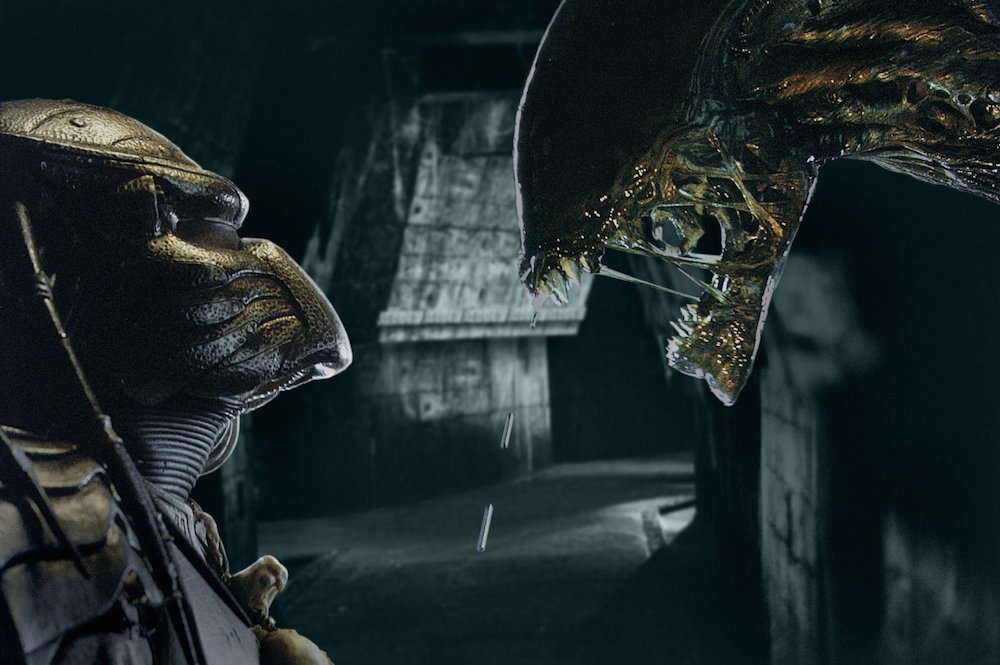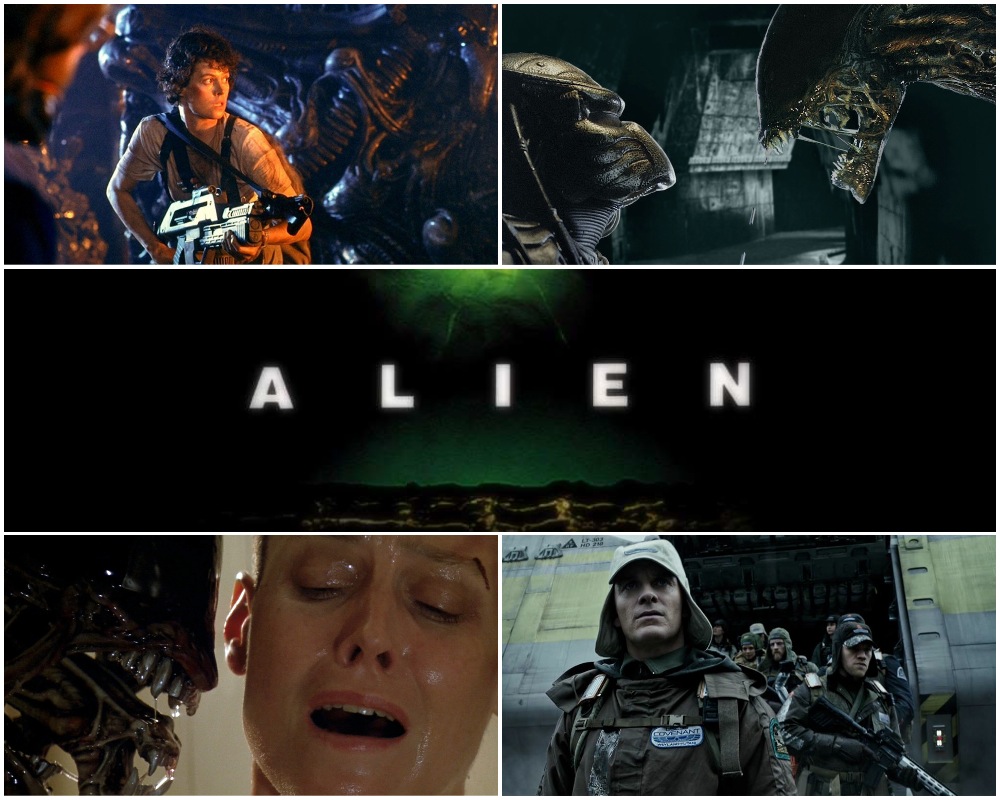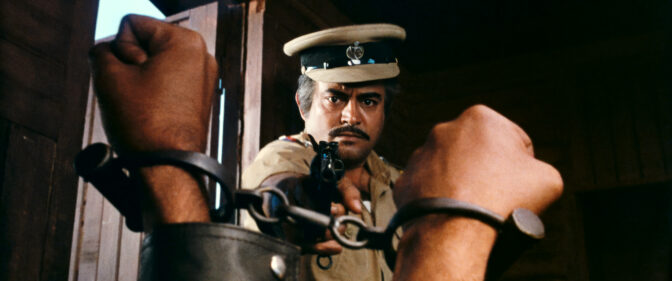With its stunning visual style, sly subversion science-fiction and horror genre conventions and one of the most terrifying and memorable monsters in screen history, “Alien” became an instant film classic from the moment it burst forth—literally—in the summer of 1979. It introduced the world to the talents of both director Ridley Scott and actress Sigourney Weaver, who became an instant star as Warrant Officer Ripley, the lone survivor of the titular creature.
Although the enormous financial success of the film made a sequel almost inevitable, such a thing seemed like a dodgy prospect from an artistic standpoint. After all, it seemed highly unlikely that any sequel could possibly equal, let alone top, the perfection that was achieved the first time around and it’s difficult to get audiences to scream at the same thing twice. “Aliens” not only met all of those inflated expectations, it exceeded them with a film that was clearly the equal of its predecessor—many have actually suggested that it was the superior movie.

Instead of merely offering a rehash of the first film, “Aliens” took the basic elements and, instead of trying to make another haunted-house-in-space story, rejiggered them into the context of a full-throttle action film that nevertheless managed to provide a genuine emotional center as well in the relationship between Ripley and a little girl named Newt (Carrie Henn, in one of the great one-off performances of recent cinema history). Like the original, “Aliens” was a critical and commercial smash and proved to be the breakthrough work for another emerging filmmaker of note, writer/director James Cameron, who got the job off the strength of his work on “Piranha 2: The Spawning” and, to a slightly greater extent, the sci-fi cult hit “The Terminator” (1984). The film even received seven Oscar nominations—a rarity for a genre film—including a much-deserved Best Actress nomination for Weaver.
The “Alien” franchise would continue over the ensuing decades with four official entries—“Alien 3” (1992), “Alien Resurrection” (1997), “Prometheus” (2012) and the brand new “Alien: Covenant”—and a couple of lesser spinoff films (more, though not too much more, about those later). But for many fans, the story pretty much ended with the sight of Ripley going into hyper-sleep for the long journey back to Earth at the end of “Aliens.” Although these follow-ups have been successful from a financial standpoint, each one has found itself being largely rejected by the fan base who felt that they were nothing more than money-grabs which failed to live up to the extraordinarily high standards set by “Alien” and “Aliens.”
This is a charge that has been leveled at most long-running film franchises from time to time and in most of those cases, the people complaining have a point. In the case of the “Alien” sequels, however, the gripes seem misguided at best and borderline crazy at worst. Instead of merely repeating what came before, each film has changed things up each time by taking the basic formula of what one can rightly expect in an “Alien” film and filtering it through different stylistic, narrative and philosophical approaches, in order to give viewers new ideas to contemplate and new terrors to leave them shivering in their seats. The resulting films—not counting those aforementioned spinoffs but including “Alien: Covenant”—have proven to be wildly ambitious works that comprise one of the most consistently excellent and intriguing screen sagas of our time and which are all ripe for reappraisal or discovery.
Although the first two “Alien” films were notoriously difficult productions, they were comparatively easy compared to the tortured development of what would become “Alien 3.” Unlike the long gap between “Alien” and “Aliens,” Fox wanted to get a new film going as quickly as possible but producers David Giler, Gordon Carroll and Walter Hill were wary of just offering up a rehash. Giler and Hill conceived a two-part narrative that would shift the focus in the first film to the evil Weyland-Yutani Corporation and why they were so hell-bent on getting their hands on one of the aliens to utilize as a potential biological weapon. This concept would feature Hicks (Michael Biehn), the lone surviving Marine from “Aliens” as the central character and limit Ripley to a brief appearance in the first part before returning in the second. Famed cyberpunk author William Gibson was hired to write a screenplay using those parameters and, following a brief flirtation with Ridley Scott, Renny Harlin, who had just had a hit with “A Nightmare on Elm Street 4: The Dream Master,” was hired to direct. Gibson’s screenplay, which had Ripley in a coma and Weyland-Yutani’s ill-fated attempt to create an alien army, was cooly received and Harlin expressed interest in telling a story that either took the story to the home planet of the aliens or had them invading Earth. After Gibson left the project, writers Eric Red (“Near Dark”) and David Twohy (“Pitch Black”) were brought in to do rewrites that were eventually rejected as well and Harlin would soon leave the project and go on to direct “The Adventures of Ford Fairlane.”
Around this time, Fox president Joe Roth realized that his studio was developing an “Alien” film without the central character of Ripley and demanded that she be reinstated. Weaver agreed to sign on and insisted that the screenplay, in contrast to the weapon-heavy “Aliens,” contain no gunplay. At the same time, Hill saw “The Navigator: A Medieval Odyssey” (1987), an audacious work in which a group of people trying to escape the Black Plague in 14th century England end up in contemporary New Zealand, and was impressed enough with it to recommend its creator, Vincent Ward, to take over “Alien 3.” Ward wasn’t captivated with the screenplays he saw and came up with a story that involved Ripley and a certain stowaway crash-landing on a small planet where everything is made of wood and which is home to a monastery whose members believe that the creature is the devil. They also believe that Ripley, and the sexual temptation she represents as the only female on the planet, is the cause of their troubles.
At first, this approach inspired interest, but people began to question both its logic and the decision to have Ripley, who was by then carrying an alien herself, die at the end. Eventually, Ward was let go—he used the fee he earned from his time on the project to help fund his beautiful 1992 film “Map of the Human Heart”—and more writers were brought in to concoct a script that used the basic outline Ward devised but changed the setting to a prison planet harboring an ore refinery. With time running short before production was set to begin, Hill and Giler rewrote the script and finally found a director when they hired David Fincher, then the creator of a number of acclaimed music videos, to make his feature filmmaking debut on a project that began shooting with seven million dollars already having been spent in development costs but without a completed script.

It is impossible to overstate just how much people hated “Alien 3” when it finally arrived in May of 1992, including Fincher himself, who felt bruised by his first experience with studio meddling and stated that the release version bore little resemblance to the one he tried to make. Viewers themselves were disappointed by the drab prison setting (early trailers had vaguely suggested that the aliens would be attacking Earth) and the depressing tone that was set right at the start by killing off all the non-Ripley survivors of “Aliens” with nary a blink and the finale in which their beloved heroine Ripley committed suicide. And yet, while it is not exactly a feel-good film by any stretch of the imagination, it is a far better work than any of its detractors believe, Fincher included, and certainly more ambitious than one might expect from any second sequel.
What is startling to discover, especially if you haven’t watched it for a while, is just how much of an influence that Fincher’s vision had on the proceedings. In much the same way that David Lynch did when he signed on to make “Dune,” he took a massive science-fiction property with enormous audience expectations regarding what should and shouldn’t be included and transformed it into what can only be described as a David Fincher film. In this world, everything is grim and bleak (albeit in the most visually stunning manner imaginable) to such an extent that when the alien finally does begin to wreak havoc, succumbing to it seems to be only slightly more painful that spending another day alive on Fiorina 161. Typical for a Fincher film, there are no uncorrupted heroes to speak of—the doomed Ripley has the alien queen growing inside her, the triumph of her fellow survivors of the previous film proves to be short-lived when they are killed in a stupid accident and even the seemingly nice doctor who befriends Ripley (leading to the first straightforward sex scene in a series that has been teeming with strangely erotic imagery right from the start) has barely finished explaining his own dark past when he goes out in an exceptionally icky manner.
However compromised it might have been in the end, this is still a Fincher film through and through and one that fits in perfectly with his distinct filmography. This became even more apparent in 2003 with the DVD release of the so-called Assembly Cut, a version of the film running some 37 minutes longer and a fairly close match to Fincher’s original rough cut.
The other secret to the success of “Alien 3” is the performance by Sigourney Weaver. In previous films, her character embodied feelings and values that one loves to see in their heroes—the ability to face awful circumstances and not only survive but conquer deep-seated fears in the process. By this point, however, she has already faced the devastating losses of her fellow crew members from two different missions and of everything that she knew and held dear back on Earth. The one element of hope that she still has to cling to is Newt and when she discovers that she wasn’t able to protect her after all, she is plunged into a sense of hopelessness and despair that is only accentuated by the fact that she is surrounded by people who, despite their own grim circumstances, have managed to find a little bit of faith in life to keep them going. Ironically, it is when she discovers that she is harboring the new Alien Queen inside her—essentially her death warrant—that she is able to pull herself together and find a certain degree of purpose in what remains of her life. These are emotional beats that are more complex than the sort that are normally found in the main character of a big-budget sequel and Weaver plays all of them beautifully—she may have been nominated for “Aliens” but her performance here is arguably better. The final image of her sacrificing herself once and for all, voluntarily plunging into a vat of molten steel while holding on to dear life to the alien already bursting from her chest, is an unexpectedly graceful and moving note on which to bring closure to her character.
With the combination of audience antipathy towards “Alien 3,” the disappointing box-office grosses (though it still made plenty of money throughout the world) and the fact that the main character had just committed a spectacular and seemingly irreversible suicide in the previous film, most people assumed that the “Alien” saga was as dead as Ripley and were therefore surprised a few years later to learn that not only was a fourth film, “Alien Resurrection,” going into production, it would even star Weaver. Compared to the tortured productions of the previous installments, this one came together with relative ease. Having impressed Fox executives with his screenplay for “Buffy the Vampire Slayer” and his uncredited work on “Speed,” Joss Whedon was hired to write a new “Alien” film, and, with Ripley dead, he elected to focus it around a clone of Newt. The studio liked his work enough but asked him to redo it as a story involving a clone of Ripley instead and Weaver was impressed enough to agree to do the film. After considering such directors as Danny Boyle (then hot off of “Trainspotting”), Bryan Singer, Peter Jackson and David Cronenberg (the mind reels as to what the latter might have done at the helm of an “Alien” film), the producers once again elected to go with an up-and-coming talent by selecting French filmmaker Jean-Pierre Jeunet, who had caused an international sensation with his visually stunning fantasies “Delicatessen” (1991) and “City of Lost Children” (1995), to make his first English-language film. Along with a supporting cast that included the likes of Ron Perlman and Dominque Pinon, both of whom had worked with Jeunet before, Dan Hedaya, Michael Wincott and Brad Dourif, the then hugely-popular Winona Ryder was brought in to serve as Weaver’s co-star.

As was the case with “Alien 3,” audiences and many critics were less than impressed with “Alien Resurrection” and while it would prove to be a hit internationally, it was by far the lowest-grossing entry in the series in the U.S. And though the film is undeniably flawed in parts, there is far more about it to admire than people were willing to admit to back in the day. The recurring decision to put the films in the hands of emerging filmmakers with distinct visual styles continued to pay dividends with the selection of Jeunet. Of course, the fact that the guy who made “Delicatessen” and “City of Lost Children” would make an extraordinary-looking film was probably not a shock but, more importantly, he brought a welcome degree of humor—albeit of the jet-black variety—to the proceedings (though never to the extent of making fun of itself) that had not been on display in the earlier installments and which was especially welcome after the uber-bleak “Alien 3.” In addition, he also displayed a flair for the big action beats as well with an extended sequence with Ripley and the others trying to dodge a pair of creatures while swimming through a flooded kitchen being the unquestioned highlight. As for the monsters themselves, one might think that they would have lost the power to shock by this time, but the film still has a couple of tricks to play, most memorably with the arrival of an alien-human hybrid that is grotesque, to be sure, but strangely lovely at the same time, especially as seen through the eyes of Ripley, who is technically its mother.
It was the chance to play a variation of Ripley that contained aspects of the very same monsters she had been battling in the previous installments (not to mention the inevitable truck full of cash) that lured Weaver back to the series and her performance here is inspired. Although she looks and sounds like our beloved hero at first glance, she manages to suggest throughout in subtle ways that there is indeed something else inside of her. Not only does this lend itself to a number of amusing moments—the most famous of which is when she uses her heightened skill set to land a seemingly impossible basketball shot—but also causes viewers to wonder exactly where her true emotional loyalties lie and whether she might indeed side with the aliens after all. She also gets a couple of very nice dramatic moments as well, such as the sequence when she accidentally stumbles upon the cloning lab and discovers the earlier versions of her that went bad for various reasons, and the surprisingly poignant one where she dispatches the hybrid alien in order to save Earth but then sheds a maternal tear as it hurtles out into the cold of space. Weaver also has a killer closing moment as well when, after having finally landed safely on Earth, Call asks Ripley what she plans to do now and, with a perfect line reading, she responds “I’m a stranger here myself.” Like the ending of “Alien 3,” it is an oddly beautiful moment and one that allows one of the most beloved characters in genre history to bring her story to a fitting and much-deserved conclusion.
Whatever one may think about “Alien 3” and “Alien Resurrection,” they were works of vision and ambition by serious-minded filmmakers that had the misfortune to follow in the footsteps of two of the greatest films of their type and wound up to a great extent suffering from the impossibly high expectations of moviegoers. In other words, they were not mere inane sequels that had nothing more on their minds than exploiting a trusted brand-name on second-rate junk designed to win a weekend or two at the box-office before more or less vanishing into the ether. The same cannot be said for the deeply dubious turn that the franchise took a few years later with the “Alien vs. Predator” spinoff films. The idea to do a story bringing together Fox’s two big monster properties was first approached in a 1989 comic book and it was then teased in “Predator 2” (1990) when an Alien was briefly seen as a trophy in a Predator spacecraft. While some fans may have been looking forward to it, many of the key creative players were less than enthused with the idea—it is said that Weaver’s contractual insistence to have Ripley die at the end of “Alien 3” was done in part to avoid having to appear in an “Alien vs. Predator” film. After James Cameron and Ridley Scott worked briefly on a fifth “Alien” film that would explain the origins of the title creatures, the somewhat less esteemed Paul W.S. Anderson was hired to co-write and direct the film.

Although presumably made as a way of doing a modern-day version of such somewhat dubious monster mash-ups as “Frankenstein Meets the Wolf Man” and “Freddy Vs. Jason,” the idea of bringing together the greatest metaphorical movie monsters of their respective time periods—the Alien representing fears of the sexual revolution of the 1970s and the Predator symbolizing the might-makes-right military mindset of the following decade—in a battle for supremacy is one that is not entirely unpromising. It might have actually been something in the hands of a smart and gifted filmmaker. Unfortunately, Anderson, who would find his true calling as the driving behind-the-scenes force of the “Resident Evil” series, was not that director. His work here is so fumbling that it hard to believe that he had even seen any of the earlier films.
Alas, “Alien vs Predator” made a lot of money (even if many of those ticket buyers came away from it disgusted and disappointed) and soon inspired its own sequel, “Alien vs Predator: Requiem” (2007), a piece of low-grade hackwork that is so embarrassing on every possible level that it makes “Alien vs Predator” seem like “Alien” (or at least “Predator”) by comparison. Having apparently learned nothing from the previous film, Fox brought Shane Salerno back to write the screenplay and, in a break in tradition from the series, it was decided not to hire an established director to head the project and instead put it in the hands of Greg and Colin Strouse, a pair of special effects artists making their directorial debut.
The Alien/Predator hybrid that was pretty much the film’s chief selling point is just stupid, both in conception (it looks like it was cobbled together from pieces out of two different model kits) and in execution (where it is as nondescript as can be). The human characters are all total bores to such an extent that it is impossible to care to even the slightest degree whether or not they live or die. In fact, the only notable aspect of the entire enterprise is how nasty and unpleasant the whole thing is. Granted, the “Alien” films have never exactly been walks in the park but when they have indulged in their moments of grisly imagery, they have largely earned them as a result of the skillful filmmaking and the fact that we are by then interested in both the story and the characters. By comparison, this film throws a lot of gore and nastiness around—in response to those who griped about the PG-13 nature of the previous film, this one is decidedly R-rated in nature—including the sight of a pregnant woman and a small child having aliens pop out of them. “Alien vs. Predator: Requiem” is not just the worst film to be tangentially related to the “Alien” franchise, it is one of the worst movies of any kind to somehow make its way in front of a camera.
At this point, the entire “Alien” franchise was pretty much on life support when, in a surprise move, Ridley Scott himself returned to the fold in order to revive it. Practically since the release of the original film, he had spoken in interviews about his desire to make a prequel that would take us to the home world of the creatures and show how they came into being. As mentioned earlier, he and James Cameron had worked on developing a script around that concept until Fox elected to go the “AvP” path instead and Scott went on to other projects. In 2009, he once again showed interest in such a story and worked on a screenplay, first with Jon Spahlts and then Damon Lindelof, who had co-created the enigmatic cult TV favorite “Lost.” As the screenplay developed, however, it began to take on its own life and word began to leak out that it was not going to be so much a traditional prequel as a separate narrative that would take place in the same universe as the “Alien” films but not be specifically connected to them. Between Scott’s return to the franchise that put him on the map, an eclectic cast that included the likes of Noomi Rapace, Charlize Theron and Michael Fassbender and an enigmatic ad campaign that still did not reveal to what extent it was part of the “Alien” saga, the expectations for “Prometheus” were sky-high when it premiered in the summer of 2012.

“Prometheus” was not the straightforward prequel that some viewers were expecting—it doesn’t end in a way that immediately ties in to the beginning of “Alien.” The film clearly takes place in the same universe, but what Scott is trying to do here, in terms of the “Alien” connection, is something more ambitious. He is trying to replicate the feeling that people had when they saw the original film—the way that it introduced viewers to a mysterious world and then slowly and deliberately built up the tension until springing the big horror beats in the second half. (This is especially tricky considering that the typical “Prometheus” viewer has presumably seen “Alien” and therefore goes into it knowing more than the characters on the screen do at any given time.) While it is doing all of that, the film is offering another storyline that finds itself grappling with some of the most basic questions regarding mankind’s existence. If we had the chance to actually meet our creators, would we take it? If so, what would we possibly say to them? Finally, what would happen if our demands for answers from our creators angered them and they decided to punish us for our transgressions in that manner?
Those who went to “Prometheus” expecting a film that simply answered all their questions about “Alien” were more than a little perplexed and quite upset to find it to be a largely original work that grappled with weighty metaphysical matters and which only occasionally connected to the “Alien” films. However, seen today, with the insane levels of pre-release long gone, it is possible to judge it on its own merits. In that regard, it remains a fascinating success that plays even better devoid of the intense pre-release hype and judged on its own merits. From a visual standpoint, the film is an absolute stunner throughout as Scott and his army of technicians have created a universe that is not dissimilar from what has been established in the previous “Alien” films while at the same time maintain a distinct feel that is all its own. Of course, Ridley Scott creating a good-looking movie is hardly a shock at this point but the work here is so intriguingly conceived and lavishly appointed—and presented in one of the few examples of contemporary 3-D cinema where the added dimension actually enhances the experience—that practically every shot could stand on its own as a work of art.
At the same time, the visuals never overwhelm the fascinating and wildly ambitious narrative that works just as well as a character-driven drama about faith, existence and fear of being abandoned by those who have created us as it does a special effects extravaganza. The film is filled with good and strong performances as well from the likes of Rapace, whose character has the same balance of toughness and vulnerability as Ripley without being a carbon copy, and Fassbender, who gives one of the best performances of his entire career as David, the rare android who is curious about what makes humans tick without ever wanting to be one himself. And yes, as the film demonstrates throughout, Scott still knows how to put together an elaborate action sequence—a sequence in which Shaw finds herself impregnated with an alien embryo and attempts to remove it via a self-induced caesarian section is a squirmy delight that is as breathlessly thrilling as anything he has ever done. Although “Prometheus” is strong enough to work on its own, it marks a nifty shift in gears that could send the franchise out in any number of directions.
“Prometheus” was a big hit at the box office but left some audiences cold, partly because of the way that it raised certain philosophical questions and then refused to answer them and partly because they didn’t feel that there was enough “Alien”-related material for it to count as a full chapter of the franchise. At first, it was announced that Scott would be making a direct continuation of “Prometheus” that would bridge the gap between it and “Alien” and feature Rapace and Fassbender, the two survivors, as the protagonists. Perhaps in response to that, Scott decided somewhere along the way that the follow-up would include more overt connections to the other “Alien” films than its immediate predecessor and that there would be a couple more films needed to tie everything together. While Rapace’s participation was a mystery, it was announced that Fassbender would return and that he would be joined by Katherine Waterston, Danny McBride, Billy Crudup, Carmen Ejogo, Amy Seimetz, Demian Bichir and, perhaps inevitably, James Franco.

Following a prologue set before “Prometheus” that sees David and Weyland having a discussion about creation—David finds it puzzling that he is immortal but cannot create anything while humans can despite their fragility and mortality—”Alien: Covenant,” which takes place roughly ten years after “Prometheus,” begins as the ship Covenant is heading to deepest space with 2,000 cryogenically frozen colonists and embryos being sent to settle a new planet when an accident rattles the ship and, despite the best efforts of android Walter (Fassbender)—an upgraded and improved model of the imperfect David—that damages the ship, kills the sleeping captain and wakes the remaining crew up ahead of schedule. While trying to get their bearings, the crew hears a radio transmission from a nearby planet that appears to be capable of sustaining life. Over the objections of Daniels (Waterston), the ship’s terraforming expert, newly appointed captain Oram (Crudup), decides to check out the planet and, if acceptable, set up there instead of traveling for several more months in a damaged ship. Upon arrival, a crew goes down to investigate. At first, things look perfect but things take a turn for the ominous when a couple members of the landing party are unknowingly infected with alien spores. Meanwhile, the others trace the signal to the crashed remains of the ship that Shaw and David had fled in at the end of “Prometheus” in order to keep looking for the engineers. Before long, the group is attacked by a swarm of aliens that kill a few of them and destroy their landing shuttle before they are rescued by David, who informs them that while approaching the Engineer planet, the black substance they collected from their previous stop was unleashed, killing the Engineer population and causing a crash that killed Shaw as well. Without going into any more detail, let us just say that there is a little more to it than that and things soon take a turn for the gross.
With “Alien: Covenant,” Scott is not only having to deal with the inflated audience expectations that are always going to greet the arrival of a new “Alien” film but also the disappointment that many felt regarding “Prometheus” and the way that its loftier philosophical concerns ended up taking prominence over the more overtly horrific elements that they expected to see. Presumably in response to the reaction of many audiences, the film fits more overtly within the parameters of the series in areas ranging from the narrative structure and character development to more incidental elements that touch on aspects of all the previous films. At the same time, Scott has not abandoned the headier existential notions of “Prometheus” that seemed to interest him more than having more creatures pop out of the darkness to kill off the cast.
Scott still knows how to deliver top-notch entertainment, and “Alien: Covenant” is as stunning as anything he has done before in that regard. From a cinematic standpoint, there is hardly a moment I can recall that does not contain some kind of visual marvel that he has cooked up with cinematographer Dariusz Wolski. The human element comes through as well with strong performances Waterston, McBride and the returning Fassbender, whose dual turn as David and Walter may well be the single best performance of his career to date with one scene—you’ll know it when you see it—in which he so completely holds the focus of viewers that they will barely notice the insane amount of technical precision that must have gone into staging it. As for the overtly horrific sequences involving alien attacks, Scott stages them with a verve and intensity than proves that he is one of the most skilled filmmakers alive. He also manages to find just the right note to end the story on in the most quietly diabolical manner imaginable.
Obviously, it is far too early to gauge where “Alien: Covenant” will end up when the history of the franchise is written—will viewers regard it as a brilliant return to form or will they feel that it has continued to stray too far from its origins for comfort? Either way, the six films in the saga (and I once again stress that I am not including the “Alien vs Predator” abominations in that count) constitute one of the most fascinating franchises in modern screen history—a collection of films that have largely refused to rest on the laurels of the original classic and have instead taken enormous risks (and sometimes paid dearly for it) in order to avoid giving viewers the rehashes they might have received had the films landed in lesser hands. This is a series that is just as ambitious, both dramatically and technically, today as it was nearly 40 years ago. The “Alien” franchise serves as proof positive that a film aimed squarely at the mass audience can still be smart and creative as well as keep you up late at night wondering if there is something lurking in the darkness.












